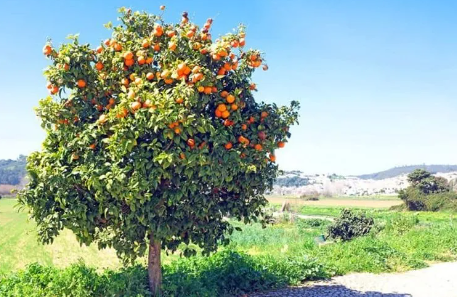
History
The navel orange gets its name from the belly-button-like formation opposite its stem, which is actually a rudimentary second fruit or “twin” that never fully develops. The first navel orange tree was discovered in 1820 in a monastery garden in Bahia, Brazil. However, it wasn’t until the mid-19th century that the navel orange as we know it today became prominent.
The navel orange was introduced to the United States in 1870 by William Saunders, a government horticulturist. He received cuttings of the tree from an American businessman in São Paulo, Brazil. These cuttings were then planted in the U.S. Department of Agriculture’s experimental gardens in Washington, D.C., which is why the most common variety is called the ‘Washington’ navel.
The most significant development occurred when Eliza Tibbets received two navel orange trees from Saunders in 1873. She planted them in Riverside, California. These trees thrived in California’s climate, leading to the widespread cultivation of navel oranges in the state. By the late 19th century, California had become a major producer of navel oranges, largely due to the success of these initial trees.
From California, the navel orange spread to other parts of the world suitable for its cultivation, including Australia, South Africa, and the Mediterranean regions. Each region developed its own varieties suited to local conditions.
Characteristics

Navel trees can grow to be quite large, often reaching heights of 15 to 25 feet when fully mature. They have a rounded canopy with a dense growth habit, which means they can provide substantial shade. Dwarf varieties might only reach 8 to 12 feet in height and spread. Navel orange trees, like many citrus trees, have a moderate growth rate when young. You can expect them to grow about 1 to 2 feet (30 to 60 cm) per year under optimal conditions.
Navel orange leaves are typically dark green, glossy, and oval-shaped with a slight point at the tip. They are usually about 4 to 6 inches long and have a smooth texture with a slightly leathery feel. The margins of the leaves can sometimes have small, fine teeth. Each leaf has a prominent midrib with several lateral veins branching off, giving it a feather-like venation pattern. The petiole (leaf stalk) is winged, which is a characteristic feature of citrus plants.
The flowers of navel orange trees are white, with a diameter of about 1-2 inches. They have five petals and are quite fragrant.
Navel oranges are mainly an eating fruit because they are seedless and their thicker skin makes them easy to peel. They are also less suitable for juice than other orange varieties as they are less juicy, and because their flesh contains limonin, which becomes bitter when exposed to air. They usually bloom in the spring. However, in regions with mild climates, they might have multiple blooming periods throughout the year.
While navel orange trees can self-pollinate, cross-pollination by bees can increase fruit set. Interestingly, navel oranges are seedless due to a genetic mutation, so even if pollinated, the fruit typically does not contain viable seeds.
The fruit of the navel orange is distinctive for its “navel” at the blossom end, which is actually a rudimentary, underdeveloped twin fruit embedded within the main fruit. The skin of navel oranges is thick and pebbly. The segments inside are easily separated. They have a sweet, juicy flesh with a low acidity. They lack the bitterness that can sometimes be found in other citrus fruits. Because they are seedless, navel oranges are perfect for eating out of hand. They are also used in juices, salads, desserts, and as a garnish.
Navel oranges are grown in many parts of the world with suitable climates, including California, Florida, Spain, Australia, and South Africa. They prefer a Mediterranean climate but can adapt to various conditions if protected from severe frost.
Most navel orange trees grow well in U.S. Department of Agriculture plant hardiness zones 9 and 10 in full sun exposure. “Washington” navel oranges (Citrus sinensis “Washington”) reach 15 to 20 feet tall, while “Dwarf Washington Navel” orange trees (Citrus sinensis “Dwarf Washington Navel”) stay 6 to 8 feet tall, which make them an ideal container tree.
When to Pick Navel Oranges
Navel oranges have a specific season, generally from late fall to early spring. In many regions, they start becoming ripe around November or December and can continue to be harvested into March or April.
Navel oranges can stay on the tree for three to four months after the fruits reach their mature size. The oranges should have a bright orange color. If they are still green or have a lot of green, they might not be ripe yet. However, some varieties might retain some green even when ripe.
The best way to check is by tasting. A ripe navel orange will be sweet and juicy, with a good balance of acidity. If it’s sour or lacks sweetness, it might need more time. Also, if the orange comes off the tree easily with a gentle twist, it’s often a sign that it’s ready. If there’s a risk of frost or extremely cold weather, it might be better to pick the oranges even if they’re not fully ripe, as cold can damage the fruit.
General Harvesting Tips
- Avoid Over-ripening: Navel oranges can remain on the tree for a while after ripening, but over time, they can lose quality. The skin might start to wrinkle, or the fruit might dry out.
- Picking: Use pruning shears or a sharp knife to cut the stem just above the fruit to avoid damaging the tree or leaving a stub that could lead to disease.
- Storage: Once picked, navel oranges can be stored at room temperature for a short period, but for longer storage, keep them in a cool place or refrigerate them.